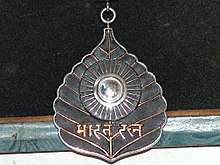Morarji Desai
Morarji Ranchhodji Desai[1] (29 February 1896 – 10 April 1995)[2] was an Indian independence activist and served between 1977 and 1979 as the 4th Prime Minister of India and led the government formed by the Janata Party. During his long career in politics, he held many important posts in government such as Chief Minister of Bombay State, Home Minister, Finance Minister and 2nd Deputy Prime Minister of India.
Morarji Desai | |
|---|---|
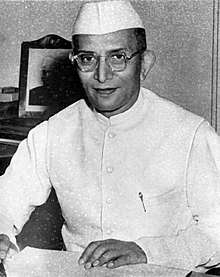 | |
| 4th Prime Minister of India | |
| In office 24 March 1977 – 28 July 1979 | |
| President | Basappa Danappa Jatti (Acting) Neelam Sanjiva Reddy |
| Deputy | Charan Singh Jagjivan Ram |
| Preceded by | Indira Gandhi |
| Succeeded by | Charan Singh |
| Minister of Home Affairs | |
| In office 1 July 1978 – 24 January 1979 | |
| Preceded by | Charan Singh |
| Succeeded by | Hirubhai M. Patel |
| 2nd Deputy Prime Minister of India | |
| In office 13 March 1967 – 16 July 1969 | |
| Prime Minister | Indira Gandhi |
| Preceded by | Sardar Vallabhbhai Patel |
| Succeeded by | Charan Singh Jagjivan Ram |
| Minister of Finance | |
| In office 13 March 1967 – 16 July 1969 | |
| Prime Minister | Indira Gandhi |
| Preceded by | Sachindra Chaudhuri |
| Succeeded by | Indira Gandhi |
| In office 13 March 1958 – 29 August 1963 | |
| Prime Minister | Jawaharlal Nehru |
| Preceded by | Jawaharlal Nehru |
| Succeeded by | T. T. Krishnamachari |
| 2nd Chief Minister of Bombay State | |
| In office 21 April 1952 – 31 October 1956 | |
| Preceded by | B.G. Kher |
| Succeeded by | Yashwantrao Chavan |
| Member of Parliament, Lok Sabha | |
| In office 1957–1980 | |
| Constituency | Surat |
| Personal details | |
| Born | Morarji Ranchhodji Desai 29 February 1896 Bhadeli, Bulsar district, Bombay Presidency, British India (present-day Valsad district, Gujarat, India) |
| Died | 10 April 1995 (aged 99) Mumbai, Maharashtra, India |
| Nationality | Indian |
| Political party | Janata Dal (1988–1995) |
| Other political affiliations | Indian National Congress (1934–1969) Indian National Congress-Organisation (1969–1977) Janata Party (1977–1988) |
| Spouse(s) | Gujraben Desai ( m. 1911) |
| Alma mater | University of Mumbai |
| Profession | |
| Awards | Bharat Ratna (1991) Nishan-e-Pakistan (1990) |
| Signature |  |
Following the passing of Prime Minister Lal Bahadur Shastri, Desai was a strong contender for the position of Prime Minister, only to be defeated by Indira Gandhi in 1966. He was appointed as Deputy Prime Minister and Minister of Finance in Indira Gandhi's cabinet, until 1969. He resigned from the Congress during the split of 1969, and joined the INC (O). After the controversial emergency was lifted in 1977, the political parties of the opposition fought together against the Congress, under the umbrella of the Janata Party, and won the 1977 election. Desai was elected Prime Minister, and became the first non-congress Prime Minister of India.
On the international scene, Desai holds international fame for his peace activism and created efforts to initiate peace between two rival South Asian states, Pakistan and India.[3] After India's first nuclear test in 1974, Desai helped restore friendly relations with China and Pakistan, and vowed to avoid armed conflict such as Indo-Pakistani war of 1971. He was honoured with the highest civilian award of Pakistan, the Nishan-e-Pakistan on 19 May 1990.
He is the oldest person to hold the office of prime minister, at the age of 81, in the history of Indian politics.[4] He subsequently retired from all political posts, but continued to campaign for the Janata Party in 1980. He was conferred with India's highest civilian honour, the Bharat Ratna. He died at the age of 99 in 1995.
Early life
Birth
Morarji Desai was born into a Gujarati Anavil Brahmin family.[5][6] His father name is Ranchhodji Nagarji Desai and his mother name is Vajiaben Desai. He was born in Bhadeli village, Bulsar district, Bombay Presidency, British India (present-day Valsad district, Gujarat, India) on 29 February 1896, the eldest of eight children. His father was a school teacher.[7]
School education and early career
Desai underwent his primary schooling in The Kundla School (now called J.V. Modi school), Savarkundla and later joined Bai Ava Bai High School, Valsad. After graduating from Wilson College, Mumbai, he joined the civil service in Gujarat. Desai resigned as deputy collector of Godhra in May 1930 after being found guilty of going soft on Hindus during the riots of 1927-28 there.[8]
Freedom fighter
Desai then joined the freedom struggle under Mahatma Gandhi and joined the civil disobedience movement against British rule in India. He spent many years in jail during the freedom struggle and owing to his sharp leadership skills and tough spirit, he became a favourite amongst freedom-fighters and an important leader of the Indian National Congress in the Gujarat region. When provincial elections were held in 1934 and 1937, Desai was elected and served as the Revenue Minister and Home Minister of the Bombay Presidency.
In government
Chief Minister of Bombay and Partition of two state

Before the independence of India, he became Bombay's Home Minister and was later elected Chief Minister of Bombay State in 1952. It was a period when movements for linguistic states were on the rise, particularly in South India. Bombay was a bi-lingual state, home to Gujarati-speaking and Marathi-speaking people. Since 1956, activist organisation Samyukta Maharashtra Samiti led a movement for a Marathi-speaking state of Maharashtra. Morarji Desai was opposed to such movements, including the Mahagujarat Movement led by Indulal Yagnik demanding a new state of Gujarat.[9] Desai proposed that the metropolitan Mumbai be made a Union territory. His logic was that a separate development region would suit the city's cosmopolitan nature, with citizens from diverse settings across various linguistic, cultural, and religious backgrounds living there for generations. Despite his Gandhian ideals, Desai ordered the police to open fire on the Samyukta Maharashtra Samiti demonstrators who had gathered at Flora Fountain to demand a Marathi-speaking state. The protesters were led by Senapati Bapat. In the carnage that followed, 105 protesters, including an eleven-year-old girl, were killed. The issue escalated and is believed to have forced the Central Government to agree to two separate states based on language. After the formation of the present State of Maharashtra, Bombay, now Mumbai became its state capital. Flora Fountain was renamed "Hutatma Chowk" ("Martyrs' Square" in Marathi) to honour the people killed in the firing. Later Desai moved to Delhi when he was inducted as finance Minister in the cabinet of Prime Minister Jawaharlal Nehru.
Nehru cabinet
Desai was socially conservative, pro-business, and in favour of free enterprise reforms, as opposed to Prime Minister Jawaharlal Nehru's socialistic policies.
Rising in Congress leadership, as a fierce nationalist with anti-corruption leanings, Desai was at odds with Prime Minister Nehru and his allies, and with Nehru's age and health failing, he was considered as a possible contender for the position of Prime Minister.
Congress party leadership contest
In 1964 after prime minister's Nehru's death, Desai was outflanked in the leadership contest by the Nehru's protege, Lal Bahadur Shastri. Desai was invited but did not join the short lived Shastri cabinet.[10] In early 1966, the unexpected passing away of Prime Minister Lal Bahadur Shastri after only 18 months in power made Morarji Desai once again a contender for the top position. However, he was defeated by Nehru's daughter, Indira Gandhi, in the Congress party leadership election by a big margin.[11]
Indira Gandhi cabinet
Desai served as Deputy Prime Minister and Finance Minister of India in the Indira Gandhi government until July 1969 when Prime Minister Gandhi took the finance portfolio from him but asked him to serve as the deputy prime minister. However, to save his self-respect, Desai tendered his resignation from the Gandhi cabinet.[12][13] Gandhi also nationalised the fourteen largest banks in India at the same time.
In opposition
When the Congress party split in 1969, Morarji joined the Indian National Congress (Organisation) faction of the party, whereas Indira Gandhi formed a new faction called Indian National Congress (Ruling). Alternatively, the two factions of Desai and Indira were called Syndicate and Indicate respectively. The 1971 general elections to the Indian parliament were won by Indira Gandhi's faction in a landslide. Morarji Desai, however, was elected as a member of the Lok Sabha or lower house of Parliament. Morarji Desai went on indefinite hunger strike on 12 March 1975 to support Nav Nirman movement of Gujarat.[14]
In 1975, Indira Gandhi was convicted of electoral fraud by the Allahabad High Court, after opponents alleged she had used government civil servants and equipment during the campaign for the 1971 General Elections.[15] During the subsequent Emergency rule in 1975–77, Desai and other opposition leaders were jailed by the Indira Gandhi government as part of a massive crackdown.
Janata wave of 1977
The popular anti-corruption movement led by Jayaprakash Narayan and the Janata-wave in 1977 led to the complete routing of the Congress party in Northern India, and a landslide victory for the opposition Janata alliance in the National elections held in March 1977. Morarji Desai was selected by the Janata alliance, later Janata Party as their parliamentary leader, and thus became the first non-Congress Prime Minister of India.[16]
Prime Minister of India (1977-79)
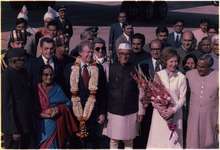
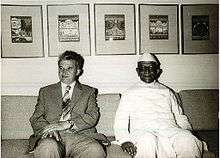
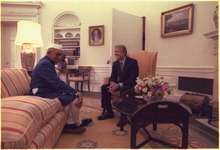


First term as a Prime Minister
In January 1977, Indira Gandhi dissolved the Lok Sabha and declared that elections to the body were to be held during March 1977. Opposition leaders were also released and promptly formed the Janata alliance to fight the elections. The alliance registered a landslide victory in the election. On the urging of Jayaprakash Narayan, the Janata alliance selected Desai as their parliamentary leader and thus the Prime Minister.[16]
Foreign policy
Desai restored normal relations with China, for the first time since the 1962 war. He also communicated with the military ruler of Pakistan, General Zia-ul-Haq and established friendly relations.Despite his pacifist leanings, he refused to sign the non-nuclear proliferation treaty despite the threat of stopping supply of uranium for power plants by the USA Congress.[17]
Nuclear programme
Domestically, Desai played a crucial role in the Indian nuclear program after it was targeted by major nuclear powers after India conducted a surprise nuclear test in 1974. Desai kept India's nuclear reactors stating "they will never be used for atomic bombs, and I will see to it if I can help it".[18] Internationally, he reaffirmed India's stand that it would not manufacture nuclear weapons and would refrain from conducting even peaceful nuclear explosions.[19] In 1977, the Carter administration offered to sell heavy water and uranium to India for its nuclear reactors but required American on-site inspection of nuclear materials. Desai declined, seeing the American stance as contradictory, in light of its own nuclear arsenal.[20]
Decimation of R&AW
Morarji Desai had described the Research and Analysis Wing (R&AW), India's external intelligence agency, as the praetorian guard of Indira Gandhi and had promised to stop all activities of the R&AW after becoming prime minister. He closed down much of the agency, and reduced its budget and operations,[21] such as closing its Information Division.[22] B. Raman, the former head of the Counter-Terrorism Division of R&AW and noted security analyst, revealed that in an informal discussion, Morarji Desai indiscreetly told Pakistan's Chief Martial Law Administrator General Zia ul-Haq that his government was well aware of Pakistan's nuclear development.[23]
Intra-party squabbles and collapse of Janata government
His government undid many amendments made to the constitution during emergency and made it more difficult for any future government to impose a national emergency. However, the Janata Party coalition was full of personal and policy friction and thus failed to achieve much, owing to continuous in-wrangling and much controversy.[24] With no party in leadership of the coalition, rival groups vied to unseat Desai. Controversial trials of prominent Congress leaders, including Indira Gandhi over Emergency-era abuses worsened the fortunes of his administration. In 1979, Raj Narain and Charan Singh pulled out of the Janata Party, forcing Desai to resign from office and retire from politics. The chief reason for the collapse was the demand by the duo and other left-leaning members, like Madhu Limaye, Krishan Kant, and George Fernandes that no member of the Janata party could simultaneously be a member of an alternative social or political organisation. This attack on "dual membership" was directed specifically at members of the Janata party who had been members of the Jan Sangh, and continued to be members of Rashtriya Swayamsevak Sangh, the Jan Sangh's ideological parent.[25]
Retirement and death
Morarji Desai campaigned for the Janata Party in 1980 General Election as a senior politician but did not contest the election himself. In retirement, he lived in Mumbai and died on 10 April 1995 at the age of 99.[26] When former French Prime Minister Antoine Pinay died in 13 December 1994, Desai became the world's oldest living former head of government. He was much honoured in his last years as a freedom-fighter of his generation.
Morarji Desai was a strict follower of Mahatma Gandhi's principles and a moralist. He was a vegetarian "both by birth and by conviction."[27]
Social service
Morarji Desai was a Gandhian follower, social worker, institution builder and a great reformer. He was the Chancellor of Gujarat Vidyapith. Even during his term as the Prime Minister he used to visit and stay at Vidyapith during the month of October. He lived simply and used to write post cards himself even when he held the office of Prime Minister. Sardar Patel deputed him to conduct meetings of farmers in Kaira district which finally led to the establishment of the Amul Cooperative movement. During his rule, he withdrew intervention in Public Distribution System and rationing shops were literally lost due to cheap sugar and oil available in the market.
Personal life
Morarji Desai married Gujraben in 1911, at the age of 15.[28] Gujraben lived to see her husband becoming Prime Minister, but she predeceased him. He has a son, Kanti Desai, and grandsons Jagdeep and Bharat Desai. Madhukeshwar Desai, one of his great-grandsons, son of Jagdeep Desai,[29] took it upon himself to revive the legacy of his illustrious great grandfather.[30] Madhukeshwar Desai is currently the National Vice-President of the Bharatiya Janata Yuva Morcha, the youth wing of the BJP.[31] Vishaal Desai, son of Bharat Desai, is a writer and filmmaker.[32]
Urine therapy
Desai, a longtime practitioner of 'urine therapy', spoke in 1978 to Dan Rather on 60 Minutes about the benefits of drinking urine. The prime minister stated that urine therapy was the perfect medical solution for the millions of Indians who cannot afford medical treatment.[33][34][35] He also attributed his longevity to drinking urine - which he called "the water of life".[36][37]
References
- The Columbia Electronic Encyclopedia. "Desai, Morarji Ranchhodji". TheFreeDictionary.com. Columbia University Press. Retrieved 8 September 2018.
- Darpan, Pratiyogita (1 December 2006). "Pratiyogita Darpan". Pratiyogita Darpan – via Google Books.
- Choudhary, Ratnadeep (10 April 2019). "Morarji Desai, the prime minister for whom time in PMO was 'tougher than prison'". ThePrint. Retrieved 26 February 2020.
- Limca Book of Records 1991. Bombay: Bisleri Beverages Ltd. 1991. p. 40. ISBN 81-900115-1-0.
- Bhattacharya, DP (26 May 2014). "Gujarati Prime Ministers Morarji Desai & Narendra Modi share similarities". The Economic Times. Gandhinagar. Retrieved 23 March 2018.
- Martel, Gordon; Lavender, Wayne (16 June 1986). Studies in British Imperial History: Essays in Honour of A.P. Thornton. Springer. p. 204. ISBN 978-1349182442.
- Kuldip Singh (10 April 1995). "Obituary: Morarji Desai". The Independent. Retrieved 23 March 2018.
- Ajay Umat & Harit Mehta (10 June 2013). "Can Narendra Modi follow in Morarji Desai's footsteps?". The Economic Times. Retrieved 10 June 2013.
- Akshayakumar Ramanlal Desai; Wilfred D'Costa (1994). State and Repressive Culture: A Case Study of Gujarat. Popular Prakashan. p. 20. ISBN 978-81-7154-702-9.
- Anwarul Haque Haqqi; Indian Political Science Association (1986). Indian Democracy at the Crossroads. Mittal Publications. p. 123. GGKEY:X2U27GYQ2L1.
- Mahendra Prasad Singh (1981). Split in a Predominant Party: The Indian National Congress in 1969. Abhinav Publications. p. 50. ISBN 978-81-7017-140-9.
- Mahendra Prasad Singh (1981). Split in a Predominant Party: The Indian National Congress in 1969. Abhinav Publications. pp. 67–68. ISBN 978-81-7017-140-9.
- "From the Archives (July 17, 1969): Morarji Desai resigns". The Hindu. 17 July 2019. ISSN 0971-751X. Retrieved 24 July 2019.
- Krishna, Ananth V. (2011). India Since Independence: Making Sense of Indian Politics. Pearson Education India. p. 117. ISBN 9788131734650. Retrieved 22 November 2012.
- "Indira Gandhi convicted of election fraud — History.com This Day in History — 6/12/1975". History.com. Retrieved 10 July 2013.
- G.G. Mirchandani (June 2003). 320 Million Judges. Abhinav Publications. pp. 177–178. ISBN 978-81-7017-061-7.
- Mohammed Badrul Alam (1988). India's Nuclear Policy. Mittal Publications. pp. 34–35. ISBN 978-81-7099-079-6.
- "The World: Morarji Desai: The Ascetic Activist". Time. 4 April 1977. Retrieved 19 March 2014.
- "PM Moraji Desai holds talks with Carter (From The Hindu's archives: 14.06.1978)". The Hindu. 26 September 2014. ISSN 0971-751X. Retrieved 16 February 2020.
- "Nation: Jimmy's Journey: Mostly Pluses". Time. 16 January 1978. Archived from the original on 1 October 2007. Retrieved 19 March 2014.
- Shaffer, Ryan (2017). "Significant Distrust and Drastic Cuts: The Indian Government's Uneasy Relationship with Intelligence". International Journal of Intelligence and CounterIntelligence. 30 (3): 522–531. doi:10.1080/08850607.2017.1263529. S2CID 157714194.
- Shaffer, Ryan (2018). "Indian intelligence revealed: an examination of operations, failures and transformations". Intelligence and National Security. 32 (4): 598–610. doi:10.1080/02684527.2017.1327135. S2CID 157485301.
- "Kaoboys of R&AW: Down Memory Lane" by B. Raman
- Mahendra Prasad Singh (1981). Split in a Predominant Party: The Indian National Congress in 1969. Abhinav Publications. pp. 8–9. ISBN 978-81-7017-140-9.
- Lloyd I. Rudolph and Susanne H. Rudolph, In Pursuit of Lakshmi: The Political Economy of the Indian State (1987), University of Chicago Press, pp 457–459.
- Hazarika, Sanjoy (11 April 1995). "Morarji Desai Dies at 99; Defeated Indira Gandhi to Become Premier of India". The New York Times.
- Shri Morarji Desai, In my view, 1966, pp. 234–235.
- Dubey, Scharada (2009). Movers and Shakers Prime Minister of India. Westland. p. Morarji Desai Section Page 1. ISBN 9788189975548. Retrieved 26 August 2014.
- Khanna, Summit (11 April 2010). "Morarji's 3G scion to enter politics". Daily News and Analysis (DNA). Ahmedabad. DNA. Retrieved 4 February 2012.
- Yagnik, Bharat (11 April 2010). "Great-grandson to revive Morarjis legacy in state". The Times of India. TNN. Retrieved 4 February 2012."Morarji's great grandson to revive legacy".
- "Morarji Desai's great grandson Madhukeshwar joins BJP's youth wing as vice-president". The Economic Times. 30 May 2013.
- "A lightly carried legacy". The Afternoon. Archived from the original on 10 May 2018. Retrieved 10 May 2011.
- Chowdhury, Prasenjit (27 July 2009). "Curative Elixir: Waters Of India". The Times of India. Archived from the original on 12 November 2017.
- Tietze, Harald (1996). Urine the Holy Water. p. 16. ISBN 0846451905.
- Wasson, R.G., 1979. Soma brought up-to-date. Journal of the American Oriental Society, 99(1), pp.100-105.
- Singh, Kuldip (1995). "OBITUARY: Morarji Desai". The Independent (Monday 10 April 1995).
- Raman, B. The Kaoboys of R&AW: Down Memory Lane. Lancer Publishers LLC. ISBN 978-1-935501-48-0. Retrieved 26 February 2020.
External links
| Wikiquote has quotations related to: Morarji Desai |

